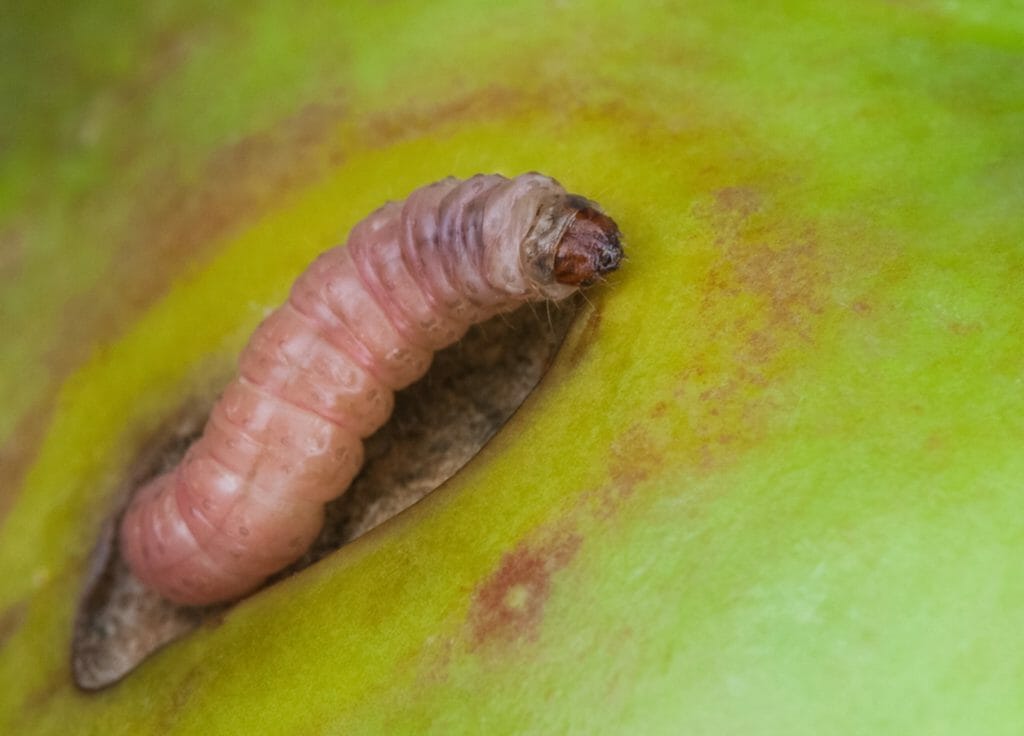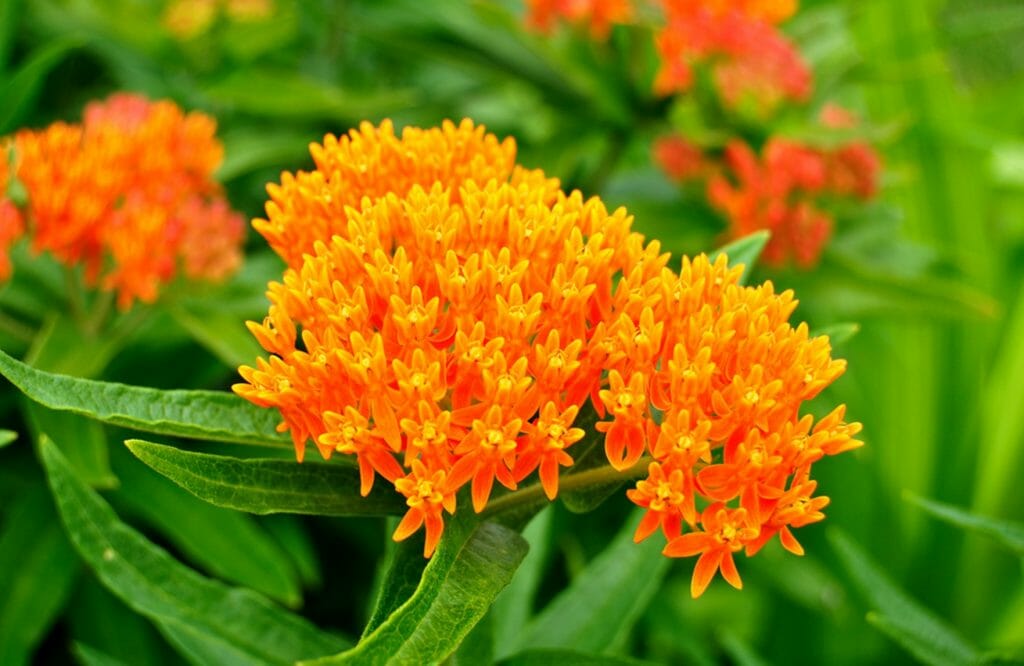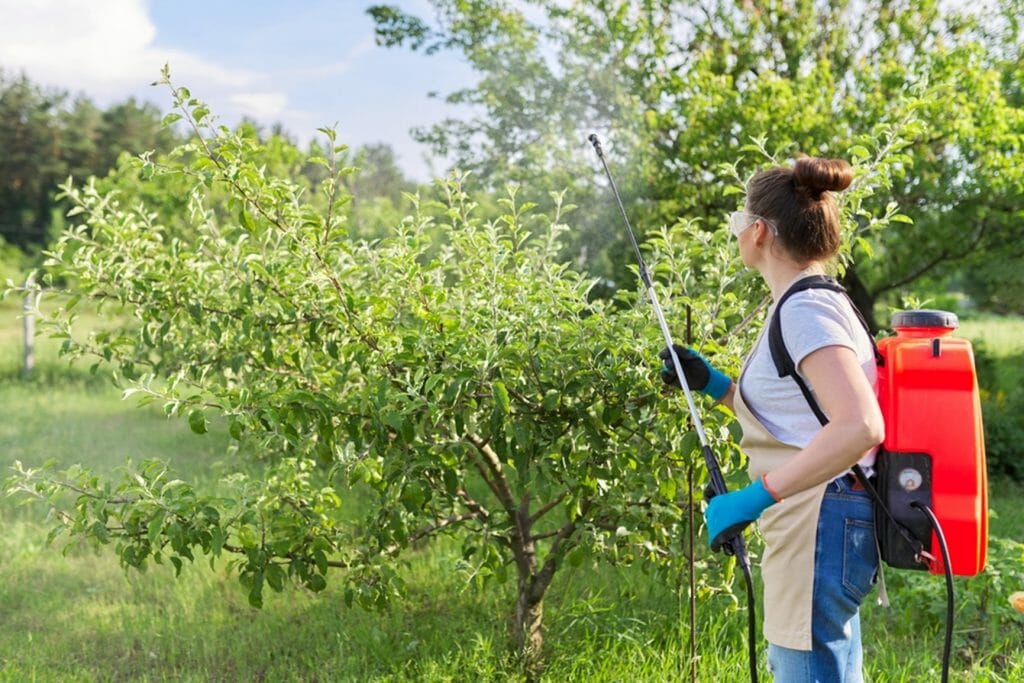Last Updated on January 24, 2022 by Zachary Smith

Are little worms invading the beautiful flesh of your apples? If so, you are not alone.
Apple tree worms are a very common pest throughout the US and can quickly wreak havoc on your fruit trees.
Fortunately, you can get rid of them using simple tips and techniques.
Here at Zachary Smith Arboriculture, we provide a variety of arbor care services to homeowners in the San Francisco Bay Area, so we understand how to get rid of apple tree worms from orchards quickly and safely — without killing beneficial insects or other plants.
Here’s what you need to know.
What are Apple Worms?
Apple worms are found in all apple-growing regions of the globe. In fact, they’re some of the most destructive apple pests out there.
Also known as codling moth larvae, apple tree worms can damage fruit from apple and pear trees and make your hard-won crops unappealing.
Adult codling moths lay eggs on emerging fruit, and the subsequent larvae feed on the fruit, boring into it from the outside.
Wondering what apple worms look like?
Codling moth larvae are creamy white or pink with a mottled brown head. Adult moths, on the other hand, are gray or brown with a ¾” wingspan and a brown patch at the tip of each forewing.
Are apple worms dangerous?
Apple worms aren’t dangerous to people, but they do lower the market value of fruit and make it unfit for consumption by humans. That said, apple worms do not carry harmful parasites or make people ill.
How do Worms Get into Apples?

Moths are cold-blooded, which means that their life cycles are dramatically influenced by the temperatures of the environment in which they live.
Generally, adult codling moths break out of their cocoons in March–April. The moth mates quickly after emergence, and females go on to lay about 70 small, disc-shaped eggs on the leaves of developing fruit.
The eggs come to maturity and hatch within about two weeks. The resulting larvae immediately begin to burrow into the fruit. During the process, they create entry wounds known as “stings.”
As the larvae feed, they push out a brown waste product called “frass.” When the worms reach the core of the fruit, they feed on the developing seeds until the worms become mature.
At that point, they emerge from the fruit, spin a cocoon, and begin the process again.
How to Keep Worms out of Apples

Here are a few tips on how to mitigate an infestation and keep the worms from invading your fruits in the first place:
Use plant-derived insecticides
Plant derived insecticides are made from natural ingredients and will have fewer harmful side effects than pesticides made from synthetic chemicals.
Additionally, they’ll break down more quickly in the environment. Spray these insecticides when 75% of the tree’s petals have fallen and apply follow-up sprays at 1–2-week intervals.
Place traps
Codling moth traps are available in most home and garden stores. These moth traps, designed to hang directly in apple or pear trees, contain a pheromone lure, which attracts male moths, traps them, and kills them. Without the presence of male moths, female moths cannot breed or produce eggs.
For best results, hang the traps facing the outside of the tree. This makes it easy for moths to enter the traps.
If you’re going to hang moth traps, it’s important to keep this in mind:
The pheromone lures lose their scent about three weeks after hanging, so you may need to swap old traps out with a new set after the first few weeks.
Hang 1-2 traps in small trees, and 2-4 traps in larger trees.
Use dormant oil
Dormant oil sprays are made from highly refined petroleum products mixed with water. When applied to trees, these oil sprays can control aphids, spider mites, and scale.
For best results, spray your trees with dormant oil just before spring, before buds begin to break open. The oil will prevent any eggs from hatching and stop your worm infestation before it starts.
Before you apply dormant oil, cover any plants around the affected trees with a tarp, since the oil can damage shrubs and flowers.
Additionally, you’ll want to make sure to spray your trees on a day when the temperature does not drop below 50 degrees Fahrenheit for the entire day. You can purchase dormant oil at your local gardening specialty store or online.
Keep the area clean
To prevent ongoing infestations, remove any fallen fruit from around the trees and discard it immediately. You also want to remove all dead fruit that’s still in the tree.
The reason for this is simple:
Fallen fruit can contain worms, which will mature into moths if left in place. Removing and disposing of the fallen fruit interrupts the reproduction process and helps you protect your other apple trees.
Band tree trunks
For a simple moth prevention tactic, place bands of corrugated cardboard (about 2-3” wide) around the trunks of your apple and pear trees, keeping the fluted side flush to the bark.
This textured surface provides a pupation site for insect larvae before they emerge as moths. Keep the trunk banks in place from late June to early fall, removing them occasionally to check for the presence of worms inside. Destroy inhabited bands and replace them with clean ones.
Monitor your trees
All season long, inspect and monitor your trees. Make sure there is no fruit on the tree with worm holes. If you find affected fruit, destroy it immediately. Good orchard sanitation will go a long way toward helping you beat codling moths.
4 Natural Home Remedies

Want to get rid of tree worms without a bunch of harsh chemicals?
Here are a few tips:
1. Deploy natural predators
One of the best ways to get rid of apple tree worms naturally is to use the worms’ natural predators. Parasitic wasps, assassin bugs, green lacewing larvae, and similar insects will eat the pests and help control their populations naturally.
Beneficial nematodes are another excellent option. These microscopic parasites destroy apple tree worms in their immature stages. For best results, spray beneficial nematodes onto the trunk and main branches of your tree, as well as around the soil at the base. You can purchase beneficial nematodes and other predators online or at a local garden store.
2. Try bagging
If you want to protect your fruit from worms, bagging can help. That said, it’s not ideal if you have a lot of apple trees on your property, since it can be time-consuming.
“Bagging” involves enclosing individual fruit in small paper bags or pantyhose to exclude moths. Most people use the kind of brown paper bags used as lunch bags.
For best results, cut a slit in the bottom of the bag, slip it over the fruit, and then staple it shut. For best results, the fruit should be covered when it is ½-1” in diameter.
3. Use sticky traps
Sticky traps are tent-shaped and made of plastic or waxed-paper. The inside of the trap contains a substance called tanglefoot, which is made of a natural, sticky substance. The lure gives off artificial female pheromones.
Male moths smell the pheromones, fly into the trap, and get stuck in the tanglefoot. These traps will reduce the population of male moths around your trees and prevent females from reproducing.
4. Plant butterfly weed
Butterfly weed is a native plant that hosts parasites that kill apple tree worms. These parasites will not damage your apples or pears, but they will kill codling moths.
For best results, plant small butterfly weed plants in the area around your apple trees, keeping them several feet from the tree’s roots. This is a simple tip that can help prevent apple tree worm damage.
2 Conventional Treatments

1. Spray your trees in the early spring
One of the best ways to keep worms out of apple trees is to spray vulnerable trees early in the season. Pros generally recommend a pyrethrin-based spray, which will kill codling moths as they begin to emerge from their cocoons, and before they start to chomp on your apples.
As a rule, spraying should occur about two weeks before your trees start to flower.
2. Spray trees after flowering
After your fruit trees have finished flowering, you can spray the tree with a Spinosad-based spray to provide an additional layer of protection against moths. Conduct this spraying when the tree has finished flowering and the fruit is just beginning to establish itself.
Generally, this spraying should begin in early April and end by late May. If you’re using moth traps, as well, monitoring the level of moths within the traps will help guide your spraying.
How do Tree Care Experts Get Rid of Apple Tree Worms?
Wondering what you can expect when you hire an expert to help you get rid of apple tree worms?
Here’s the process our team follows:
1. Comprehensive inspection
We start each job with a comprehensive property inspection. Since trees don’t get sick overnight, we begin by interviewing our customers to identify when the infestation started, and which plants are affected. We’ll also inspect affected trees to assess the extent of the existing damage.
2. Diagnosis
Once we’ve inspected your property and your sick trees, we’ll diagnose the issues facing them. For example, some properties may only have an apple tree worm infestation, while others may have co-occurring pest issues. No matter what, we’ll come up with a comprehensive management plan that will restore your trees to good health.
3. Action planning
The next step is to create a plant health care action plan to address pressing issues and restore the health of your plants. In addition to getting rid of apple tree worms, our plan will also address other concerns which could be weakening your trees.
If your soil is lacking, for example, we may recommend making amendments to improve nutrient levels. If you’re facing acute pest infestations, we may prescribe using pesticides.
Regardless of the problem, we’ll always teach you the skills and tactics to maintain your property and keep your landscaping as strong and beautiful.
4. Initial and follow-up treatments
Once we’ve composed our action plan, we’ll deliver treatments for your trees. After the initial treatment, we’ll follow up with you regularly to make sure our plan is working and deliver follow-up treatments, if needed.
Are Worms Invading Your San Francisco Bay Area Apple Fruit Trees? We’re Here to Help!
If your apple trees are filled with worms, you don’t have to throw in the towel. Zachary Smith Arboriculture is here to help! We help residential properties from Northern California – from Marin to Monterey – get rid of worms.

